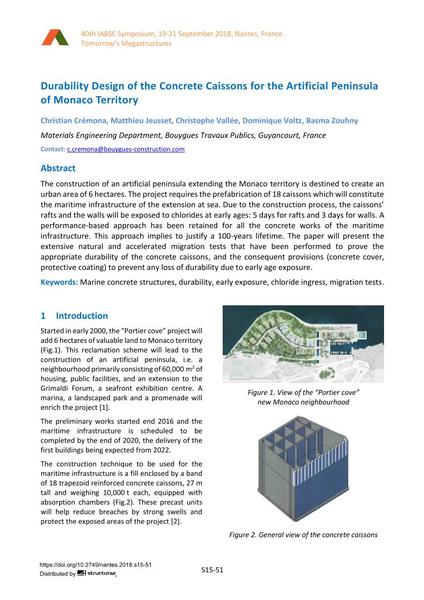Durability Design of the Concrete Caissons for the Artificial Peninsula of Monaco Territory

|
|
|||||||||||
Détails bibliographiques
| Auteur(s): |
Christian Crémona
(Materials Engineering Department, Bouygues Travaux Publics, Guyancourt, France)
Matthieu Jeusset (Materials Engineering Department, Bouygues Travaux Publics, Guyancourt, France) Christophe Vallée (Materials Engineering Department, Bouygues Travaux Publics, Guyancourt, France) Dominique Voltz (Materials Engineering Department, Bouygues Travaux Publics, Guyancourt, France) Basma Zouhny (Materials Engineering Department, Bouygues Travaux Publics, Guyancourt, France) |
||||
|---|---|---|---|---|---|
| Médium: | papier de conférence | ||||
| Langue(s): | anglais | ||||
| Conférence: | IABSE Symposium: Tomorrow’s Megastructures, Nantes, France, 19-21 September 2018 | ||||
| Publié dans: | IABSE Symposium Nantes 2018 | ||||
|
|||||
| Page(s): | S15-51 | ||||
| Nombre total de pages (du PDF): | 8 | ||||
| DOI: | 10.2749/nantes.2018.s15-51 | ||||
| Abstrait: |
The construction of an artificial peninsula extending the Monaco territory is destined to create an urban area of 6 hectares. The project requires the prefabrication of 18 caissons which will constitute the maritime infrastructure of the extension at sea. Due to the construction process, the caissons’ rafts and the walls will be exposed to chlorides at early ages: 5 days for rafts and 3 days for walls. A performance-based approach has been retained for all the concrete works of the maritime infrastructure. This approach implies to justify a 100-years lifetime. The paper will present the extensive natural and accelerated migration tests that have been performed to prove the appropriate durability of the concrete caissons, and the consequent provisions (concrete cover, protective coating) to prevent any loss of durability due to early age exposure. |
||||
